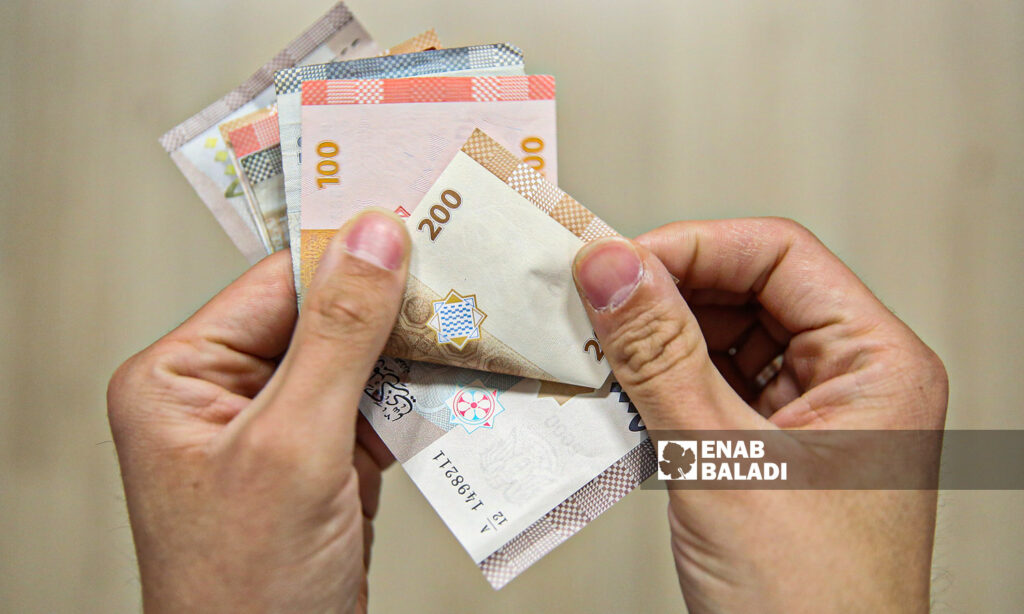Latakia – Linda Ali
For many years, the “Jam’iyya” has been a popular choice for many employees for equipping a home, buying expensive items, or even purchasing gold for savings. Today, it has become a means to purchase clothes, supplies, or festival necessities.
The “Jam’iyya” is similar to a loan but without interest. A group of people agrees to contribute a certain amount of their salary each month, with each individual receiving the total amount on a rotating basis until everyone has received their share.
Mania (39), a government employee, mentioned that since her appointment years ago, she hardly remembers ever receiving her full salary as she always participates in “Jam’iyya” for various purposes. Today, all the gold she owns was bought through previous “Jam’iyyat” when the Syrian pound was stable against foreign currencies.
Nowadays, Mania sets a specific date to collect the “Jam’iyya”, either at the beginning of the school year to buy her children’s supplies or in March to buy Mother’s Day gifts for her mother and her mother-in-law.
Previously, the monthly contribution was either 500 or 1000 Syrian pounds, lasting a year, which could total up to 6000 or 12,000 Syrian pounds, depending on the monthly amount. Now, the monthly contribution ranges from 25,000 to 50,000 Syrian pounds, with an average salary of about 290,000 Syrian pounds.
The minimum wage across various control areas in Syria necessitates finding additional sources of income, either by securing a second job or relying on money transfers from abroad, an option not available to everyone.
The selling rate of the US dollar against the Syrian pound is 14,900 pounds, and the buying rate is 14,750 pounds, according to the S-P Today website.
The impact of salary decline
Abeer (45) joined a “Jam’iyya” at the beginning of the year, hoping to receive it in April to buy clothes for her daughter before the preparatory exams, as private tutoring expenses consumed her entire monthly salary, in addition to the salary from her home-based job during holidays.
Unfortunately, her colleagues did not agree to give it to her in April and decided to conduct a draw to determine each person’s turn, especially after they disagreed on who would receive it first. Her turn came in March, which she exchanged with a colleague.
The amount of the “Jam’iyya” reached 600,000 Syrian pounds, a sum in which she barely managed to buy a pair of jeans, a T-shirt, and a pair of sneakers for her daughter from a local market in Latakia. In the past, Abeer managed to buy all her house necessities, from furniture to kitchenware, through a “Jam’iyya” of 20,000 pounds over ten months, in addition to another similar one from her engagement days in 2004.
Abeer noted that most of her colleagues no longer participate in “Jam’iyyat,” often facing challenges in gathering enough participants and having to include relatives from outside work to reach the required number, mostly due to the poor financial circumstances of most employees who spend their salaries paying off debts from the moment they receive them at the beginning of each month.
“Jam’iyyat” of retailers
The “Jam’iyya” among retail sellers significantly differs from that of government employees, ranging from six million to twelve million Syrian pounds, with a monthly contribution of half a million to a million pounds.
Issa (37), who owns a wholesale grocery store in one of the villages of Salanfah area, shared that he joined with other nearby sellers in a “Jam’iyya” valued at twelve million Syrian pounds, where each contributes a million monthly.
The main issue, he said, was about who would receive it first, due to the fluctuating exchange rate and ongoing depreciation of the Syrian pound. Nevertheless, they find a way to agree by drawing lots.
Numbers are written on separate pieces of paper, and each participant draws one. The person who picks “1” receives the amount of the “Jam’iyya” first, and so on, with everyone agreeing to the draw.
In Syria, 16.7 million people are in need of humanitarian aid, according to estimates by the UNHCR.
About 80% of the Syrian population will require some form of humanitarian aid in 2024, as per the Humanitarian Needs Overview (HNO) for 2024.
Furthermore, approximately 55% of the population, or 12.9 million people, suffer from food insecurity, with 3.1 million severely affected.

